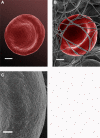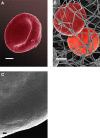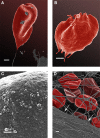High ferritin levels have major effects on the morphology of erythrocytes in Alzheimer's disease
- PMID: 24367334
- PMCID: PMC3853801
- DOI: 10.3389/fnagi.2013.00088
High ferritin levels have major effects on the morphology of erythrocytes in Alzheimer's disease
Abstract
Introduction: Unliganded iron both contributes to the pathology of Alzheimer's disease (AD) and also changes the morphology of erythrocytes (RBCs). We tested the hypothesis that these two facts might be linked, i.e., that the RBCs of AD individuals have a variant morphology, that might have diagnostic or prognostic value.
Methods: We included a literature survey of AD and its relationships to the vascular system, followed by a laboratory study. Four different microscopy techniques were used and results statistically compared to analyze trends between high and normal serum ferritin (SF) AD individuals.
Results: Light and scanning electron microscopies showed little difference between the morphologies of RBCs taken from healthy individuals and from normal SF AD individuals. By contrast, there were substantial changes in the morphology of RBCs taken from high SF AD individuals. These differences were also observed using confocal microscopy and as a significantly greater membrane stiffness (measured using force-distance curves).
Conclusion: We argue that high ferritin levels may contribute to an accelerated pathology in AD. Our findings reinforce the importance of (unliganded) iron in AD, and suggest the possibility both of an early diagnosis and some means of treating or slowing down the progress of this disease.
Keywords: Alzheimer's disease; atomic force microscopy; erythrocytes; iron; scanning electron microscopy.
Figures










Similar articles
-
Profound morphological changes in the erythrocytes and fibrin networks of patients with hemochromatosis or with hyperferritinemia, and their normalization by iron chelators and other agents.PLoS One. 2014 Jan 9;9(1):e85271. doi: 10.1371/journal.pone.0085271. eCollection 2014. PLoS One. 2014. PMID: 24416376 Free PMC article.
-
The peripheral blood of Aβ binding RBC as a biomarker for diagnosis of Alzheimer's disease.Age Ageing. 2015 May;44(3):458-64. doi: 10.1093/ageing/afv009. Epub 2015 Feb 11. Age Ageing. 2015. PMID: 25673873
-
Abnormal red blood cell morphological changes in thalassaemia associated with iron overload and oxidative stress.J Clin Pathol. 2019 Aug;72(8):520-524. doi: 10.1136/jclinpath-2019-205775. Epub 2019 Apr 22. J Clin Pathol. 2019. PMID: 31010830
-
Diagnostic morphology: biophysical indicators for iron-driven inflammatory diseases.Integr Biol (Camb). 2014 May;6(5):486-510. doi: 10.1039/c4ib00025k. Integr Biol (Camb). 2014. PMID: 24714688 Review.
-
Structure and function in native and pathological erythrocytes: a quantitative view from the nanoscale.Micron. 2012 Dec;43(12):1273-86. doi: 10.1016/j.micron.2012.03.019. Epub 2012 Apr 3. Micron. 2012. PMID: 22537716 Review.
Cited by
-
Exploring the ex vivo effects of Naja mossambica venom on the ultrastructure and viscoelastic properties of human blood.Res Pract Thromb Haemost. 2023 Dec 9;8(1):102294. doi: 10.1016/j.rpth.2023.102294. eCollection 2024 Jan. Res Pract Thromb Haemost. 2023. PMID: 38292349 Free PMC article.
-
Metabolic Influences Modulating Erythrocyte Deformability and Eryptosis.Metabolites. 2021 Dec 21;12(1):4. doi: 10.3390/metabo12010004. Metabolites. 2021. PMID: 35050126 Free PMC article. Review.
-
Morphometric and Nanomechanical Screening of Peripheral Blood Cells with Atomic Force Microscopy for Label-Free Assessment of Alzheimer's Disease, Parkinson's Disease, and Amyotrophic Lateral Sclerosis.Int J Mol Sci. 2023 Sep 19;24(18):14296. doi: 10.3390/ijms241814296. Int J Mol Sci. 2023. PMID: 37762599 Free PMC article. Review.
-
Viscoelastic and ultrastructural characteristics of whole blood and plasma in Alzheimer-type dementia, and the possible role of bacterial lipopolysaccharides (LPS).Oncotarget. 2015 Nov 3;6(34):35284-303. doi: 10.18632/oncotarget.6074. Oncotarget. 2015. PMID: 26462180 Free PMC article.
-
The dormant blood microbiome in chronic, inflammatory diseases.FEMS Microbiol Rev. 2015 Jul;39(4):567-91. doi: 10.1093/femsre/fuv013. Epub 2015 May 3. FEMS Microbiol Rev. 2015. PMID: 25940667 Free PMC article. Review.
References
LinkOut - more resources
Full Text Sources
Other Literature Sources

